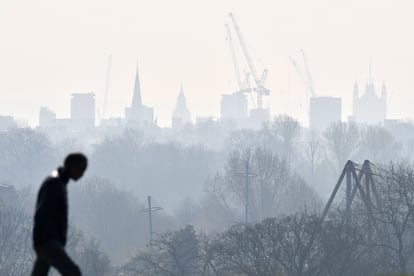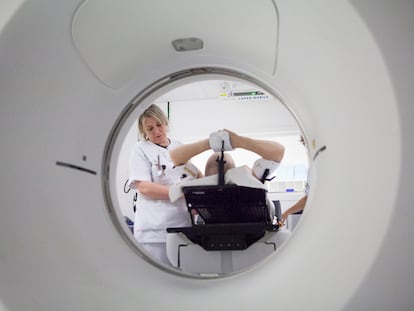Study reveals that pollution can cause lung cancer in thousands of non-smokers
The analysis of more than 30,000 patients in Europe, America and Asia suggests that fine particles cause tumors

In recent years, oncologists have faced a growing phenomenon that they don’t know how to explain: more and more people develop lung cancer without ever smoking. Such patients make up about 15% of all cases.
A new study indicates one of the causes: the tiny particles suspended in polluted air. The work analyzes the levels of 2.5 micra particles (PM 2.5) — the tiniest ones in the fuel combustion smoke— and the incidence of lung cancer in 33,000 non-smokers in the United Kingdom, Canada, South Korea and Taiwan. The authors focus on people with mutations in the EGFR gene, a marker of lung cancer in people who have never smoked or have done so very sporadically. The results show a clear association between air pollution levels and the appearance of tumors.
“The study demonstrates a new paradigm for how cancer appears,” says oncologist Charles Swanton, researcher at London’s Francis Crick Institute and the main author of the study, which scientists from Europe, Asia and North America participated in.
Until now, it was thought that cancerogenic agents in the environment damaged DNA, producing mutations, and that genetic changes provoked the later development of tumors. But the new study demonstrates that particles in the air cause cancer in healthy people who happen to have mutations that predispose them to lung cancer, like EGFR.
The study indicates that just three years of breathing polluted air can cause the incidence of lung cancer in non-smokers to take off. In Europe, according to the European Union, 96% of the urban population is exposed to levels of PM 2.5 particles above the recommendations by the World Health Organization.
Swanton emphasizes the importance of the findings, published in the magazine Nature. “Air pollution kills eight million people every year around the world. Some of those are people who have never smoked but have the EGFR mutation,” he explains. In Europe, they make up about 15% of patients, but in Asia the percentage can reach 75%. “It’s the first time that it’s been shown that a carcinogenic compound can lead to cancer without causing mutations. We think this is just the beginning. It’s very possible that the other 19 known carcinogenic compounds generate tumors via similar mechanisms,” he adds.
The researchers demonstrated in mice that fine particles provoke inflammation of the respiratory system, which leads to lung tumors in patients with mutations that predispose them to cancer.
Esteve Fernández, a lung cancer expert and researcher at the Catalan Oncology Institute, explains that PM 2.5 particles “penetrate the lungs, pass through the bronchioles and reach the bloodstream.” “They have a diameter of 2.5 micras, while epithelial cells are about 10 micras. So their effect is like throwing stones at a person,” he says. Though it was already known that air contamination provokes thousands of deaths via cardiovascular accidents and cancer, the researcher believes that the study reveals key details about the particles’ role in causing cancer. “With this information, governments and companies should feel more responsibility and understand that their actions have a price on health,” he says.
Mariano Provencio, lung cancer expert and oncologist at the Puerta de Hierro Hospital of Madrid, says, “There was already consensus about how pollution affects lung cancer in non-smokers. This demonstrates it.” “The study opens new possibilities, like detecting people who have the EGFR or KRAS mutations, which increase their risk of suffering the illness if they’re exposed to pollution,” he adds.
Luis Paz-Ares, director of the lung cancer unit at the National Center of Oncological Research in Spain, explains another conclusion from the new study. Researchers have demonstrated in rats that fine particles cause the immune system to generate inflammation, which leads to tumors. The inflammatory protein interleukin-1 beta is key in that process. Scientists have demonstrated that blocking the molecule can stop the appearance of lung tumors. “There is an experimental drug called canakinumab that blocks interleukin-1 beta. In a study with more than 10,000 patients, the drug showed a significant reduction in lung cancer, which was unexpected as it was developed to prevent myocardial heart attacks,” Paz-Ares explains. “This opens the door to anti-inflammatory treatments to prevent lung cancer,” she adds.
Laura Mezquita, spokesperson for the Spanish Society of Medical Oncology, believes that the work supports a “paradigm shift” regarding lung cancer. Although 85% of lung tumors are due to tobacco, “not everything can be attributed to that.” “What the study demonstrates is that, if you have two lungs, you have a risk of lung cancer even if you don’t smoke and have a healthy lifestyle, because you can’t escape pollution. Reducing that risk factor depends on the authorities. And the most important thing is that risk factors add to each other, like, for example, smoking and living in a big city with a lot of pollution,” she explains.
The geneticist at the Clinical Hospital of Barcelona gives a caveat to the new work. It is very difficult to know if those patients’ tumors were caused by pollution or other environmental factors. For example, radon gas is the second-greatest carcinogenic agent after tobacco. It is not yet clear how to calculate its effects on these patients.
Swanton’s group wants to go on to study other external factors, like the impact of alcohol on esophageal cancer or obesity’s effect on different types of tumors. “We have an enormous field to explore,” he says.
Sign up for our weekly newsletter to get more English-language news coverage from EL PAÍS USA Edition
Tu suscripción se está usando en otro dispositivo
¿Quieres añadir otro usuario a tu suscripción?
Si continúas leyendo en este dispositivo, no se podrá leer en el otro.
FlechaTu suscripción se está usando en otro dispositivo y solo puedes acceder a EL PAÍS desde un dispositivo a la vez.
Si quieres compartir tu cuenta, cambia tu suscripción a la modalidad Premium, así podrás añadir otro usuario. Cada uno accederá con su propia cuenta de email, lo que os permitirá personalizar vuestra experiencia en EL PAÍS.
¿Tienes una suscripción de empresa? Accede aquí para contratar más cuentas.
En el caso de no saber quién está usando tu cuenta, te recomendamos cambiar tu contraseña aquí.
Si decides continuar compartiendo tu cuenta, este mensaje se mostrará en tu dispositivo y en el de la otra persona que está usando tu cuenta de forma indefinida, afectando a tu experiencia de lectura. Puedes consultar aquí los términos y condiciones de la suscripción digital.
More information
Archived In
Últimas noticias
Most viewed
- Reinhard Genzel, Nobel laureate in physics: ‘One-minute videos will never give you the truth’
- Pablo Escobar’s hippos: A serious environmental problem, 40 years on
- Charles Dubouloz, mountaineering star, retires at 36 with a farewell tour inspired by Walter Bonatti
- Why we lost the habit of sleeping in two segments and how that changed our sense of time
- The fall of a prolific science journal exposes the billion-dollar profits of scientific publishing











































